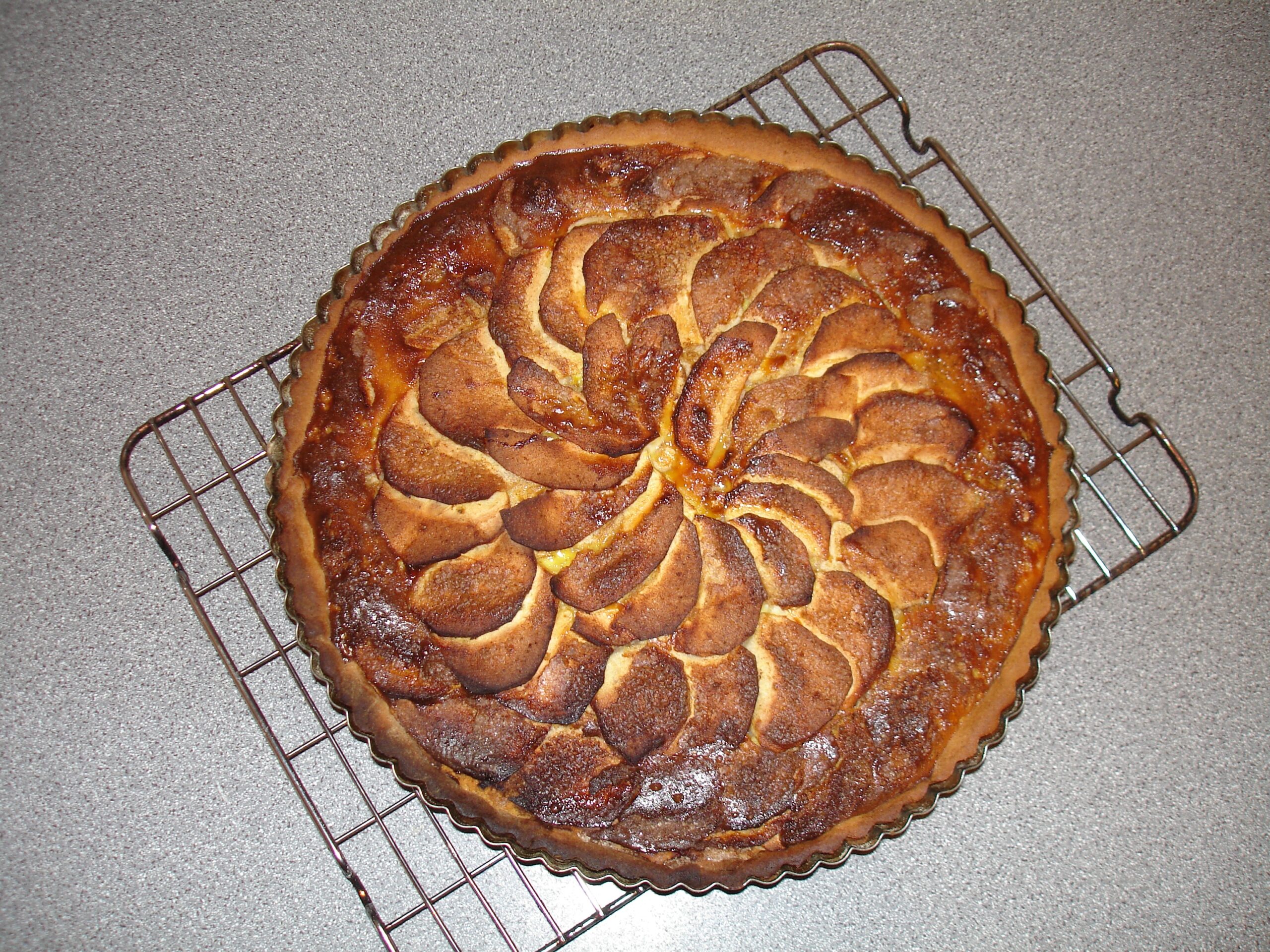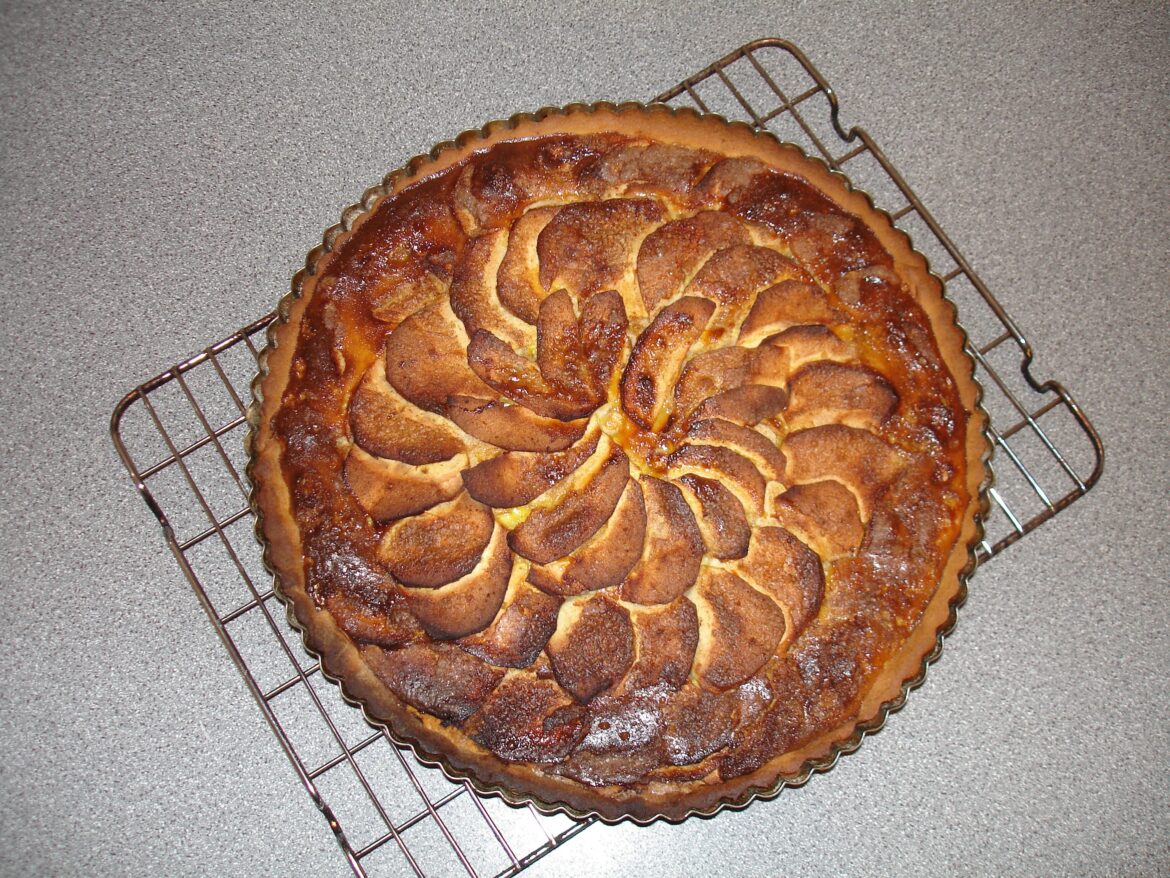A word of explanation before we go on. This is not an apple pie as such (the techniques are a lot different though the flavorings are similar). This is a home version of apfelwähe, which is a subset of the larger set of wähen or tarts in general. (I’m using the Swiss name, which is regional: in Germany and Austria, these sometimes go by other names.)
Wähen come in both sweet and savory forms — filled with all kinds of seasonal fruit, as well as with quiche-style fillings — and bakeries in Switzerland routinely have both kinds ready to go, by the slice, like pizza. A favorite lunch with people in a hurry would be a slice of a cheese- or meat- or vegetable-based wähe and a slice of a fruit one — plum, apricot, apple, whatever’s in season — with a glass of wine or a soft drink like Rivella.

Work with the dough right out of the refrigerator if possible: this may make matters slightly easier for you. If you have the kind of tart pan/tin the recipe properly calls for — 10-12 inches wide, with a one-inch high, fluted rim and a removable bottom — roll the dough out just thin enough to be about an inch and a half wider than the pan, and either fold it in two for the move into the pan, or drape it over the rolling pin and move it that way. Carefully tuck the dough down so that it is flat both against the pan’s bottom and the fluted sides. Press it gently against the fluting: then trim it off flat by rolling the rolling pin over the top edge. Save the trimmings for some smaller piece of pastry work (you might have enough left over to line a cupcake’s worth of cupcake pan). Prick the bottom of the crust-to-be with a fork.
If you don’t have a tart tin, use a small baking sheet with a rim. (I’m thinking something about 12″ by 9″.) Line this with the pastry and prick the bottom.
Whichever pan/tin you’re using, set it aside (preferably in the refrigerator) while you deal with the next batch of ingredients. Which are:
For the filling proper —
- Approximately two pounds of a tart baking apple (Bramley is best: Granny Smith is okay. Try to avoid “eating” apples like the Delicious crowd. Rome is good if you can get it, but always prefer green to red.)
- 3 oz / 75g ground almonds
- Grated rind of 1 lemon, or 1 tsp dried lemon zest
- 3 tsp fine granulated sugar / caster sugar (UK)
- 2 tsp ground cinnamon
- 1 oz butter, cut into flakes (or use a butter curler to produce this much butter in short curls)
For the custard: —
- 8 oz whipping cream
- 1 tsp cornstarch / cornflour (UK)
- 2 large eggs
- 1 egg yolk
- 4 tbs fine granulated sugar / caster sugar
Preheat the oven to 190C / 375F (about ten degrees lower if you have a fan oven).
Sprinkle the bottom of the pastry-lined pan/tin with the ground almonds. Combine the cinnamon, sugar and lemon zest in a small bowl.
Peel, core and quarter the apples. Slice them very thin (I use a mandoline-type vegetable slicer for this), toss them together with the cinnamon-sugar-zest mixture, and then arrange them in concentric circles on top of the ground almonds. Flake the butter on top.
Mix the cornstarch well with about three tablespoonsful of the cream: then add this to the rest of the custard ingredients and mix well. Put the pastry in the oven and bake for fifteen minutes. When this time has elapsed, stir up the custard ingredients well one more time, then pour enough custard into the pastry to fill it to the top. Close the oven and bake for another 30 minutes. (If the pastry was showing too much browning at the 15-minute stage, you might want to decrease the heat just a little.) At the end of the 30 minutes, wiggle the pan a little to make sure that the custard’s set. If it is, remove and allow to cool on a rack. If it isn’t, give it another five or ten minutes, but no more.
This can be served hot, warm, or cold. Add whatever sides you prefer with an apple dessert. In the UK, it would usually be double cream, or more custard. The idea of cheddar cheese alongside seems not to have reached these shores as yet, but I do it and it works fine for me. (And it raises the thought of an apfelwähe with a cheddar crust, which would be interesting…)

